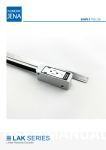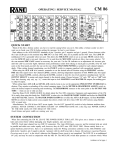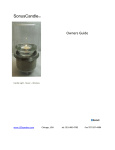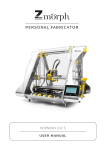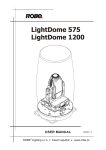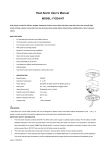Download ADJUSTMENT TOOL
Transcript
SIMPLY PRECISE USER MANUAL ADJUSTMENT TOOL For NUMERIK JENA Encoders with Online Compensation 2 Index 1. Features and Applications ���������������������������������������������������������������������������������������������������� 3 1.1 1.2 1.3 1.4 2. EPIFLEX Software ������������������������������������������������������������������������������������������������������������������ 4 2.1 2.2 3. Wiring Diagram ���������������������������������������������������������������������������������������������������������������������� 8 3.1 3.2 4. Electronic Signal Adjustment ��������������������������������������������������������������������������������������������� 10 4.1 5. Interface Settings ����������������������������������������������������������������������������������������������������������������� 12 6. Pin Assignment of the Diagnostic Connector ������������������������������������������������������������������ 12 Functions of the ADJUSTMENT TOOL ������������������������������������������������������������������������ Dynamic Offset and Amplitude Control (Online Compensation) ���������������������������������� Scope of Delivery ��������������������������������������������������������������������������������������������������������� Suitable Encoders �������������������������������������������������������������������������������������������������������� 3 3 3 3 EPIFLEX - Installation Guide ��������������������������������������������������������������������������������������� 4 EPIFLEX - Range of Functions ������������������������������������������������������������������������������������ 5 Connecting Variants of the Diagnostic Connector ������������������������������������������������������� 8 Connection of the Encoder to the ADJUSTMENT TOOL Hardware ���������������������������� 9 Hints to the Automatic Signal Adjustment ������������������������������������������������������������������ 11 7.Troubleshooting ������������������������������������������������������������������������������������������������������������������� 13 8. Ordering Information ����������������������������������������������������������������������������������������������������������� 14 SIMPLY PRECISE 3 1. Features and Applications Before delivery the encoders from NUMERIK JENA will be tested and electronically adjusted under ideal mounting conditions. Furthermore, the sensor modules offer the possibility of an electronic signal adjustment after the mounting into the application. This allows the user optimize the encoder signals regarding to the mechanical mounting conditions (tolerances). The ADJUSTMENT TOOL and the related EPIFLEX software was designed to simplify and make the signal adjustment more effective. 1.1 • • • • • • Functions of the ADJUSTMENT TOOL Representation of the sinusoidal counting signals with amplitude, offset and phase position Representation of the position and width of the index signal Evaluation of the mechanical mounting conditions Automatic signal adjustment and programming of the sensor module Electronic readjustment of the amplitude and offset of the sensor signals Adjustment of the position and width of the index signal 1.2 Dynamic Offset and Amplitude Control (Online Compensation) The encoders of NUMERIK JENA are equipped with a dynamic amplitude and offset control (online compensation). The analog diode signals will be corrected to their nominal values in real time. This reduces measuring errors caused by contamination of the scale tape as well as from inaccuracies in the guide way. The phase position between the sine and cosine signals and the position of the index signal are not influenced by the online compensation. With help of the EPIFLEX Software the preadjusted nominal values of the online compensation can be influenced (see page 7, “Online Compensation - Tab”). 1.3 • • • • • Scope of Delivery ADJUSTMENT TOOL black box Diagnostic cable to connect the measuring system USB cable to connect a PC USB - D-SUB - adapter cable (15-pin) Exchangeable 8-pin plug connectors 1.4 Suitable Encoders The ADJUSTMENT TOOL is suitable for the following NUMERIK JENA - products: LIA 20 LIA 21 LIA 22 LIK 11 LIK 21 LIK 22 LIK 23 LIK 41 Kit L2 Kit L4 LIK 2D RIK 4 Kit R RIA SIMPLY PRECISE 4 2. EPIFLEX Software The EPIFLEX software was especially designed for the ADJUSTMENT TOOL. It offers the user versatile possibilities to bring the encoder into service. It also allows the user to display the sensor signals and evaluate them without using an oscilloscope or other expensive hardware. Furthermore it is possible to program respectively optimize the encoder to the existing mounting conditions automatically. The EPIFLEX software is available for free via download on the NUMERIK JENA website under www.numerikjena.de. Furthermore, one can order the software with an optional USB flash drive (see chapter 9). The EPIFLEX software is suitable for the following operating systems: • Windows 7 / 8 (32 or 64 bit) 2.1 EPIFLEX - Installation Guide Unzip the downloaded installation file or connect the optional USB flash drive to your PC. Run the setup file and follow the instructions shown in the installation window. Image 1 For software updates please visit our website. In our download portal you will always find the latest version for free. We provide these software packages usually as a zipped folder. Please unzip this folder after the download, run the setup file and follow the installation instructions. If an older software version is installed, it is not necessary to uninstall it before. ATTENTION! Please installl the software first, only then connect the ADJUSTMENT TOOL to your PC! SIMPLY PRECISE 5 2.2 EPIFLEX - Range of Functions 1 1 2 3 4 5 6 7 8 9 2 3 4 5 6 7 8 9 Image 2 Opens a file with saved parameter Saves current parameters to a file Reads the data from the connected sensor module Saves the current parameters to the connected sensor module permanently Undoes the last changed settings after connecting / saving Window for counting signals • Green area: shows the tolerance limits • Red circle: shows the signal optimum • Blue circle: shows the actual signal as a Lissajous figure Starts the automatic signal adjustment Button for the online compensation (ON / OFF) Sensor number SIMPLY PRECISE 6 Index Signal Window 10 11 12 13 14 Image 3 15 10 Signal window for the index impulse • Green signal period: Sine signal • Red signal period: Cosine signal • Blue signal: Index impulse 11 Controller for adjustment of the index • Change of position 12 Controller for adjustment of the index • Change of width 13 Drop-down menu for signal output (interface) • 1 VPP (for sensor modules with and also without integrated signal interpolation) • 3 VPP (for sensor modules with external interpolation electronics / PCB) 14 Controller to change the time base of the software oscilloscope 15 Readout for the time-based value SIMPLY PRECISE 7 Adjustment - Tab With Adjustment - Tab it is possible to do a manual signal adjustment. The online compensation must be deactivated. The following parameter which have direct influence to the counting signals (Lissajous-figure) can be adjusted: • • • • • LED current Sine offset Cosine offset Signal amplitude of the sine signals* Signal amplitude of the cosine signals Image 4 Online Compensation - Tab With help of the Online Compensation - Tab it is possible to influence the preadjusted nominal values of the online compensation. However, normally this is not necessary. The online compensation must be activated. The online compensation adjusts the amplitudes of the sine and cosine signals dynamically. For monitoring functions the range of adjustment of the sine and cosine amplitude parameters can be visualized by activating the option “Update Controls”. Because of a permanent data communication signal errors can occur. Therefore this option should not be activated permanently.* Image 5 Options - Tab The Options - Tab allows to activate or deactivate the error or monitoring signal (NAS). Furthermore the interface of the scanning head (1 VPP or RS 422), the speed index of the sensor module and the counting direction can be changed.* By using a RS 422 sensor w/o signal interpolation it is necessary to adjust the interface. Only then the counting signals can be displayed. If the automatic signal adjustment will be started this adjustment is not necessary. In this case the interface will be set automatically. Image 6 Among other things the Options - Tab displays ID and serial number of the sensor module.* * Encoders with external interpolation electronics or depending on the kind of the integrated sensor amplifier, these options will possibly not be supported. SIMPLY PRECISE 8 3. Wiring Diagram The encoders from NUMERIK JENA have an 8-pin diagnostic connector for signal evaluation and for adjustment. Depending on the model, this connector is either in the scanning head (LIA 20 measuring systems only) or in the D-Sub connector. The code on the ID label indicates the location of the connector. ATTENTION! The power supply must be shut off when connecting or disconnecting the diagnostic connector! Connect the diagnostic connector to the diagnostic socket as shown in the graphics with the connecting variants. Please pay attention to the white marking on the diagnostic connector! For encoders with signal processing (interpolation) in the scanning head, the head’s housing cover must be removed carefully. If the signal is processed in the connector, then the connector must be opened. Connecting Variants of the Diagnostic Connector D-Sub connector scanning head 2 diagnostic socket connector PCB diagnostic socket Connector PCB: RS 422 with interpolation Please use diagnostic socket „2“! Scanning head PCB: 1VPP or RS 422 without interpolation Scanning head PCB: RS 422 with interpolation diagnostic socket diagnostic socket Scanning head PCB (LIA 20) Connector PCB: 1VPP or RS 422 without interpolation Scanning head PCB (LIA 20) D-Sub connector scanning head 1 connector PCB 3.1 Image 7 SIMPLY PRECISE 9 Connection of the Encoder to the ADJUSTMENT TOOL Hardware or Scanning head PCB (LIA 20) diagnostic socket diagnostic socket D-Sub connector adapter cable connector PCB D-Sub connector scanning head 3.2 USB PC USB diagnostic socket USB Black Box Image 8 ATTENTION! Please pay attention to the following during the signal adjustment: Any noise disturbances which are interfering with the measuring system can lead to incorrect signal settings. This will cause non-optimal signal parameters during function. During the signal adjustment the signals of the encoder should not be used to control the drive motor. Unintentional misadjustments could cause wrong signal values in the controller and lead to malfunction of the drive system. The stage should be moved without motorized drive during the signal adjustment. If a motorized drive is necessary, a manual operation has to be used and the encoder feedback must not be used. Encoder system, stage, ADJUSTMENT TOOL and controller must have the same ground and earth potential. Use the included USB - D-SUB - adapter cable during the adjustment to supply the measuring system with power over your PC, not over your controller! If you are not in possession of the USB - D-SUB - adapter cable, you can order it separately from NUMERIK JENA (see chapter 8). SIMPLY PRECISE 10 4. Electronic Signal Adjustment With the EPIFLEX software you are able to adjust signal influencing parameters manually (see page 7). Ocassionally, that can be inconvenient, time-consuming and imprecise. Therefore, the EPIFLEX software provides an automatic adjustment function which allows you to adjust and optimize all parameter settings automatically very fast as well as easy. To start the automatic adjustment please proceed as described in the following: 1. Click on the green Start - Button to start the automatic adjustment procedure. Subsequently a status window appears. 2. Please follow the instructions displayed in the status window! 3. Move the read head to the scale back and forth. In doing so it is important to cross a reference mark to ensure that the system can also adjust this parameter correctly. Please cross the reference mark in both directions! 4. At the bottom of the main window a green progress bar will be displayed. This bar shows the progress of the adjustment. The status window displays the progress of each adjusted parameter. 5. If the adjustment is done, please click on the Save - Button. By doing so the new adjusted parameter will be saved to the sensor module. Image 9 ATTENTION! Before you start the electronic adjustment please pay attention to any contamination on the scale. This can affect the adjustment process negatively. Clean the surface of the scale with a soft microfibre cloth and acetone if necessary. SIMPLY PRECISE 11 4.1 Hints to the Automatic Signal Adjustment The movement of the measuring system during the automatic signal adjustment should be as steady as possible. In the window for the index impulse 2 to 6 signal periods should be displayed. Otherwise adjust the movement speed or regulate the time base of the software oscilloscope, please. If the status window displays the message “Missing signals or too less/many periods to calculate the parameters”, it is an indication that the movement of the measuring system is too slow or too fast. In this case please adjust the movement speed in an appropriate way. Furthermore, you should pay attention that you cross the reference mark during the movement. If you get error messages in the status window after the adjustment it may have several reasons. In this case please start the automatic adjustment procedure again to verify a legitimate failure. Additionally, please pay attention to our mounting instructions in the data sheet of the measuring system. Often, problems occur because of a transgression of the mechanical mounting tolerances. In chapter 8 we have compiled some potential error causes. If these error causes do not apply to your application, please contact us. Image 10 If the automatic adjustment procedure is finished successfully, you can use the encoder at full capability. If you change something regarding your mounting conditions afterwards, e.g. disassembling and renewed assembling of the scanning head, it is recommended to do the automatic adjustment again. SIMPLY PRECISE 12 5. Interface Settings The EPIFLEX software recognizes the output interface of the sensor automatically during startup of the automatic signal adjustment. If the EPIFLEX software is used to check the sensor signals only, possibly an interface setting must be done (see page 6 and 7). Following settings are valid: Signal processing Scanning head Connector Interface Output interface 1 VPP 1 VPP 1 VPP / 3 VPP RS 422 with interpolation RS 422 RS 422 with interpolation 1 VPP 1 VPP 3 VPP RS 422 with interpolation RS 422 RS 422 with interpolation 6. Chart 1 Pin Assignment of the Diagnostic Connector Pin Signal Description 1 SCL Serial Clock (white marking on diagnostic connector) 2 SDA Serial Data 3 RI Index rough impulse 4 Um Middle voltage 5 A+ Sine+ 6 B+ Cosine+ 7 CS not used 8 GND GND Chart 2 SIMPLY PRECISE 13 7.Troubleshooting We have listed some possible error causes and solutions below. If this is not helpful, please contact the technical support of NUMERIK JENA GmbH or one of our authorized representations. You will find respective contact data on the NUMERIK JENA webside www.numerikjena.de. Error Possible cause Solution Sensor data deleted. Everything set to standard values (0 or 255) Please contact NUMERIK JENA Incorrect sensor settings Load the sensor values again Amplitude or offset cannot be changed with the controllers Online compensation is active Switch off the online compensation Amplitude or offset are not changed by mechanical adjustment Online compensation is active Switch off the online compensation Mounting of the scanning head outside permitted tolerances Check the mounting conditions Position and size of the rough pulse outside permitted tolerances Set the rough pulse correctly Mounting of the scanning head outside permitted tolerances Check the mounting conditions Rough pulse too wide Set the rough pulse correctly Incorrect sensor values No reference mark detected Double index impulse No rough index pulse visible on the “Position” value greater than oscilloscope “Width” “Position” must be less than “Width” Chart 3 SIMPLY PRECISE 14 8. Ordering Information Name ADJUSTMENT TOOL Scope of delivery / Description • ADJUSTMENT TOOL black box • Diagnostic cable to connect the measuring system • USB cable to connect a PC • USB - D-SUB - adapter cable (15-pin) • Exchangeable 8-pin plug connectors Order-no. Description External flash drive with saved EPIFLEX software to supply the measuring system with voltage via PC Order-no. 344220-33 Optional Single Components Name EPIFLEX software - USB flash drive USB - D-SUB - adapter cable (15-pin) 686802-02 341693-0M USB - D-SUB - adapter cable (15-pin) Required components (not included): • PC with OS Windows 7 / 8 (32 or 64 bit) SIMPLY PRECISE 15 SIMPLY PRECISE NUMERIK JENA GmbH Im Semmicht 4 07751 Jena Germany Phone: +49 3641 4728-0 Fax: +49 3641 4728-202 E-Mail:[email protected] www.numerikjena.de Subject to change without prior notice. version 10_2 2015 ℗ & © NUMERIK JENA GmbH SIMPLY PRECISE
















